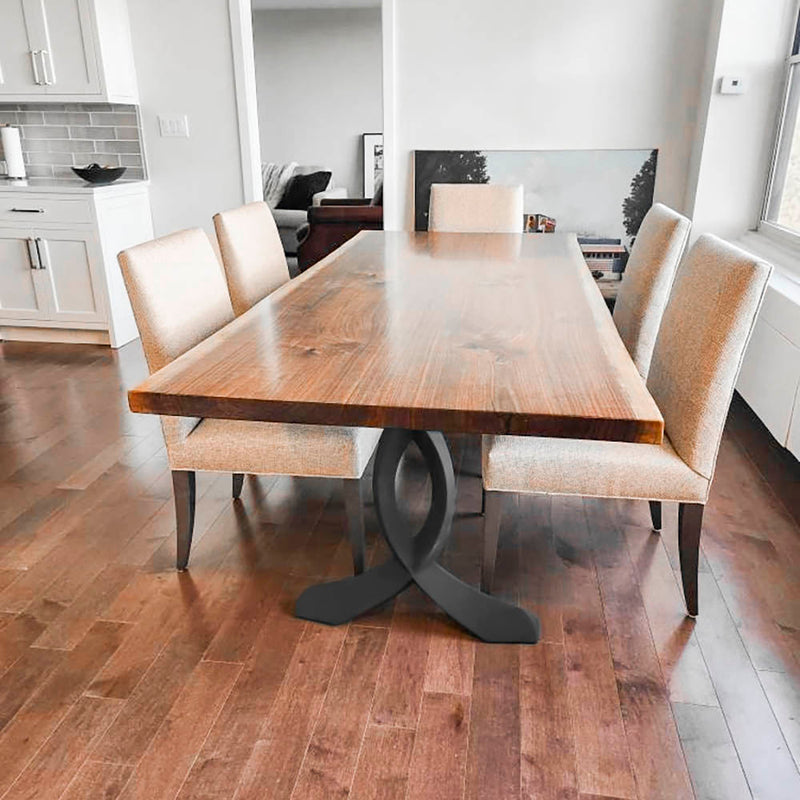From Traditional to Modern: Locate the Suitable Dining-room Table Legs for Your Design
While traditional layouts such as cabriole and turned legs stimulate a sense of ageless refinement, contemporary styles like barrette and geometric options present an opportunity for striking aesthetic rate of interest. As you think about these components, the question remains: just how can you effortlessly incorporate these diverse leg designs to produce an unified dining experience?
Understanding Table Leg Styles
The selection of dining room table leg styles can considerably influence both the visual appeals and performance of the area. Each leg design contributes special practical features and visual aspects, catering to diverse design choices and usage requirements. Recognizing these styles is important for picking the best table that aligns with your overall interior decoration vision.
For circumstances, conical legs use a clean, classic look that can boost a room's elegance, while stand bases supply security and maximize legroom, making them ideal for smaller sized areas. Barrette legs, a characteristic of mid-century contemporary design, present a commercial flair, allowing for an airy, open feeling. Trestle legs evoke rustic appeal, supplying robust assistance and a sense of eternity.
In addition, the selection of materials plays a substantial function. Wooden legs can bring heat and appearance, whereas metal alternatives typically convey a streamlined, modern vibe. Inevitably, comprehending table leg designs is crucial for developing a cohesive eating area that shows individual style while making certain functionality and comfort. By attentively considering these elements, you can improve both the visual and practical appeal of your dining room.
Typical Table Leg Options
When picking dining-room table legs, traditional choices often embody classic style and craftsmanship. These styles show an abundant heritage and a commitment to high quality, making them excellent for those who appreciate traditional looks.
Among one of the most iconic traditional leg designs is the cabriole leg, characterized by its stylish rounded form. This layout typically features decorative carvings and is most commonly found in Queen Anne and Chippendale furniture. Another prominent choice is the turned leg, which boasts a series of smooth, rounded forms that supply a traditional appearance while preserving stability.
Moreover, the straight leg, while straightforward, offers a tough and unadorned structure that can mix perfectly with a range of tabletop styles. For those attracted to ornate outlining, claw-and-ball feet legs evoke a feeling of grandeur and can function as a stunning focal point in any eating room.
Finally, stand bases, although not purely legs, offer an alternate traditional option that permits adequate legroom and can be magnificently carved. Each of these conventional leg styles adds to the overall ambiance of an eating space, marrying feature with aesthetic allure.

Modern Table Leg Designs
Modern table leg designs offer a varied series of designs that emphasize ingenious products and clean lines. These designs frequently focus on functionality while functioning as striking focal points within an eating room. Minimal looks best site prevail, with legs crafted from products such as metal, glass, and engineered timber, which contribute to a contemporary and ventilated feeling.
One popular style is the barrette leg, identified by its slender, conical framework that offers security without frustrating the tabletop (dining room table legs). This style is often located in mid-century modern furniture and can easily complement different eating table forms. Another pattern is the usage of geometric forms, where legs may handle asymmetrical or angular types, including aesthetic rate of interest and a touch of artistry

Mixing Designs for Special Areas
Commonly, house owners look for to produce special dining spaces that reflect their individual design by mixing different style elements. This approach enables the consolidation of varied visual appeals, leading to a harmonious yet distinct setting. For instance, combining a rustic wooden table with sleek, modern-day steel legs can produce an appealing contrast that elevates the area's general appeal.
Additionally, integrating vintage table legs with modern tabletops can stimulate a feeling of history while keeping a contemporary sensibility. Such mixes not just showcase private taste however also encourage creative thinking, enabling homeowners to curate an area that feels both personal and inviting.
Shade plays a vital role in this mixing process; choosing table legs that match or contrast with the existing shade plan can boost visual rate of interest. Whitewashed legs can soften the daring Resources of a dark table surface area, developing a well balanced visual.
Tips for Selecting the Right Legs
Choosing the right table legs is vital for achieving both functionality and visual allure in your dining area. Begin by taking into consideration the overall design of your room. Conventional setups gain from legs that include elaborate makings or turned styles, while modern rooms might call for sleek, minimal designs.
Following, evaluate the height and stability of the legs. dining room table legs. Common table range between 28 to 30 inches in height, so make sure the legs enhance this dimension for convenience. Furthermore, durable products, such as wood or steel, can boost security and longevity
Assess the leg shape also-- choices consist of directly, tapered, or home stand layouts. Straight legs use a timeless look, while tapered legs can include a touch of style. Pedestal bases give ample legroom and are perfect for smaller spaces.
Final Thought
In summary, selecting the ideal eating space table legs requires mindful factor to consider of both modern and standard styles. By integrating leg design, elevation, and product with the general décor, a natural and inviting ambience can be attained.
The range of dining area table leg styles can significantly affect both the aesthetics and capability of the area. Inevitably, comprehending table leg designs is necessary for creating a natural eating location that reflects individual style while making sure practicality and convenience.One of the most renowned typical leg styles is the cabriole leg, defined by its elegant rounded shape. Straight legs supply a classic look, while conical legs can add a touch of style.In summary, choosing the ideal dining area table legs needs careful consideration of both conventional and contemporary styles.